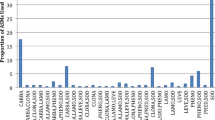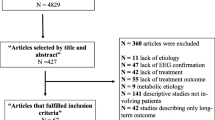Abstract
Purpose
The aim of this study is to examine the factors affecting seizure recurrence in pediatric patients diagnosed with epilepsy.
Methods
Three hundred patients presenting to the pediatric neurology clinic between 2015 and 2018 and diagnosed with epilepsy and treated with single antiseizure drug were included in the study. Medical histories and clinical and laboratory findings were retrieved retrospectively from the hospital data system. The combined and adjusted effects of risk factors on seizure recurrence were evaluated using multivariate binary logistic regression analysis.
Results
Boys had a higher rate of seizure recurrence than girls. Seizure recurrence was also higher in patients with abnormal neurological examinations at the time of diagnosis compared to those with normal neurological examinations. Seizure recurrence was significantly higher in patients with global growth retardation. Epilepsy patients with abnormal MRI findings also had a higher rate of seizure recurrence than patients with normal neuroimaging findings. In addition, seizure recurrence was significantly higher in epilepsy patients with comorbidities such as cerebral palsy and autism spectrum disorders compared to patients without comorbidities. No significant association was observed between seizure recurrence and the first drug, perinatal asphyxia history, localization of epileptiform discharges on EEG, family history of epilepsy, family history of febrile seizures, history of stay in the neonatal intensive care unit during the perinatal period, or preterm delivery.
Conclusion
Abnormal neurological examination, abnormal neuroimaging and accompanying comorbidities, and global growth retardation at the time of diagnosis are important factors affecting seizure recurrence in pediatric patients with epilepsy.
Similar content being viewed by others
Data availability
The data of the present study can be requested from the corresponding author.
References
Fisher RS, Acevedo C, Arzimanoglou A et al (2014) ILAE official report: a practical clinical definition of epilepsy. Epilepsia 55:475–482
Aaberg KM, Bakken IJ, Lossius MI et al (2018) Short-term seizure outcomes in childhood epilepsy. Pediatrics 141:e20174016
Åndell E, Tomson T, Carlsson S et al (2015) The incidence of unprovoked seizures and occurrence of neurodevelopmental comorbidities in children at the time of their first epileptic seizure and during the subsequent six months. Epilepsy Res 113:140–150
Annegers JF, Shirts SB, Hauser WA, Kurland LT (1986) Risk of recurrence after an initial unprovoked seizure. Epilepsia 27:43–50
Arthur TM, deGrauw TJ, Johnson CS et al (2008) Seizure recurrence risk following a first seizure in neurologically normal children. Epilepsia 49:1950–1954
Berg AT (2008) Risk of recurrence after a first unprovoked seizure. Epilepsia 49:13–18
Berg AT, Rychlik K, Levy SR, Testa FM (2014) Complete remission of childhood onset epilepsy: stability and prediction over two decades. Brain 137:3213–3222
Geerts A, Arts WF, Stroink H et al (2010) Course and outcome of childhood epilepsy: a 15-year follow-up of the Dutch Study of Epilepsy in Childhood. Epilepsia 51:1189–1197
Wirrell E, Wong-Kisiel L, Mandrekar J, Nickels K (2012) Predictors and course of medically intractable epilepsy in young children presenting before 36 months of age: a retrospective, population-based study. Epilepsia 53:1563–1569
Sartori S, Nosadini M, Tessarin G et al (2019) First-ever convulsive seizures in children presenting to the emergency department: risk factors for seizure recurrence and diagnosis of epilepsy. Dev Med Child Neurol 61:82–90
Rizvi S, Ladino LD, Hernandez-Ronquillo L, Téllez-Zenteno JF (2017) Epidemiology of early stages of epilepsy: Risk of seizure recurrence after a first seizure. Seizure 49:46–53
Fisher RS, Cross JH, D’Souza C, French JA, Haut SR, Higurashi N, Hirsch E, Jansen FE, Lagae L, Moshé SL, Peltola J, Roulet Perez E, Scheffer IE, Schulze-Bonhage A, Somerville E, Sperling M, Yacubian EM, Zuberi SM (2017) Instruction manual for the ILAE 2017 operational classification of seizure types. Epilepsia 58(4):531–542
Anlar B, Yalaz K (1996) Denver II gelişimsel tarama testi Türk çocuklarına uyarlanması ve standardizasyonu el kitabı Ankara Meteksan Matbası.
Savaşır I, Şahin N (1995) Wechsler intelligence scale handbook for children. Turkish Psychologists Association Publications Ankara
Gilad R, Lampl Y, Gabbay U, Eshel Y, Sarova-Pinhas I (1996) Early treatment of a single generalized tonic-clonic seizure to prevent recurrence. Arch Neurol 53:1149–1152
Winckler MI, Rotta NT (2004) Clinical and electroencephalographic follow-up after a first unprovoked seizure. Pediatr Neurol 30:201–206
Paliwal P, Wakerley BR, Yeo LL et al (2015) Early electroencephalography in patients with emergency room diagnoses of suspected new-onset seizures: diagnostic yield and impact on clinical decision-making. Seizure 31:22–26
Mizorogi S, Kanemura H, Sano F, Sugita K, Aihara M (2015) Risk factors for seizure recurrence in children after first unprovoked seizure. Pediatr Int 57:665–669
Shinnar S, Berg AT, Moshé SL et al (1990) Risk of seizure recurrence following a first unprovoked seizure in childhood: a prospective study. Pediatrics 85:1076–1085
Pereira C, Resende C, Fineza I, Robalo C (2014) A 15-year follow-up of first unprovoked seizures: a prospective study of 200 children. Epileptic Disord 16:50–55
Hauser WA, Rich SS, Lee JR, Annegers JF, Anderson VE (1998) Risk of recurrent seizures after two unprovoked seizures. N Engl J Med 338:429–434
Kim LG, Johnson TL, Marson AG, Chadwick DW, MRC MESS Study group (2006) Prediction of risk of seizure recurrence after a single seizure and early epilepsy: further results from the MESS trial. Lancet Neurol 5:317–322
Oskoui M, Webster RI, Zhang X, Shevell MI (2005) Factors predictive of outcome in childhood epilepsy. J Child Neurol 20:898–904
Morrell MJ (2002) Folic acid and epilepsy. Epilepsy Curr 2:31–34
Mattson RH, Gallagher BB, Reynolds EH, Glass D (1973) Folate therapy in epilepsy. A controlled study Arch Neurol 29:78–81
Acknowledgements
We would like to thank all the children and their families who participated in this study on a voluntary basis.
Author information
Authors and Affiliations
Contributions
All authors contributed to all study data, revised, and approved the final version of the manuscript. YBK and FH designed the study, and YBK acquired the data. HA and SA analyzed the data; YBK, FH, and NK drafted the manuscript.
Corresponding author
Ethics declarations
Ethical approval
This study was approved by the Bolu Abant Izzet Baysal University Clinical Research Ethics Committee (license number: 2019/317), and all procedures carried out in the study involving human participants were in accordance with the 1964 Helsinki Declaration and its later amendments or comparable ethical standards.
Informed consent
Informed consent was obtained from all individual participants for whom identifying information is included in this article.
Conflict of interest
The authors declare that they have no conflict of interest.
Additional information
Publisher's Note
Springer Nature remains neutral with regard to jurisdictional claims in published maps and institutional affiliations.
Supplementary Information
Below is the link to the electronic supplementary material.
Rights and permissions
About this article
Cite this article
Kilinc, Y.B., Hancı, F., Ankaralı, H. et al. Risk factors affecting seizure recurrence in childhood epilepsy during short-term follow-up. Childs Nerv Syst 37, 2857–2863 (2021). https://doi.org/10.1007/s00381-021-05227-3
Received:
Accepted:
Published:
Issue Date:
DOI: https://doi.org/10.1007/s00381-021-05227-3




